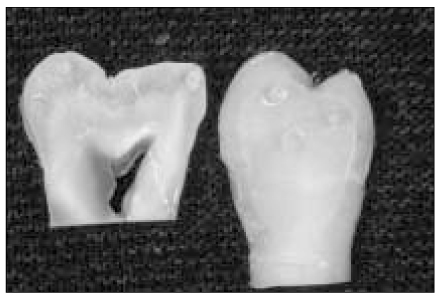References
1. Inoue S, Vargas MA, Abe Y, Abe Y, Yoshida Y, Lambrechts P, Vanherle G, Sano H, Van Meerbeek B. Microtensile bond strength of eleven contemporary adhesives to enamel. Am J Dent 2003. 16329–334.
2. Cardoso PFC, Meloncini MA, Placido E, Lima JDO, Tavares AU. Influence of the substrate and load application method on the shear bond strength of two adhesive systems. Oper Dent 2003. 28(4)388–394.
3. Dickens SH, Milos MF. Relationship of dentin shear bond strengths to different laboratory test designs. Am J Dent 2002. 15185–192.
4. Fanchi M, Breschi L. Effects of acid-etching solutions on human enamel and dentin. Quintessence Int 1995. 26431–435.
5. Gilpatrick RO, Ross JA, Simonsen RJ. Resin-to-enamel bond strengths with various etching times. Quintessence Int 1991. 2247–49.
6. Hannig M, Reinhardt KJ, Bott B. Self-etching primer vs phosphoric acid: an alternative concept for composite-to-enamel bonding. Oper Dent 1999. 24172–180.
7. Hara AT, Amaral CM, Pimenta LAF, Sinhoreti MAC. Shear bond strength of hydrophilic adhesive systems to enamel. Am J Dent 1999. 12181–184.
8. Ikeda T, Uno S, Tanaka T, Kawakami S, Komatsu H, Sano H. Relation of enamel prism orientation to microtensile bond strength. Am J Dent 2002. 15109–113.
9. Toledano M, Osorio R, de Leonardi G, Rosales-Leal JI, Ceballos L, Cabrerizo-Vilchez MA. Influence of self-etching primer on the resin adhesion to enamel and dentin. Am J Dent 2001. 14205–210.
10. Pashley DH, Tay FR. Aggressiveness of contemporary self-etching adhesives. part II : etching effects on unground enamel. Dent Mater 2001. 17430–444.
11. Fabianelli A, Kugel G, Ferrari M. Efficacy of self-etching primer on sealing margins of class II restorations. Am J Dent 2003. 1637–41.
12. Torii Y, Itou K, Nishitani Y, Ishikawa K, Suzuki K. Effect of phosphoric acid etching to self-etching primer application on adhesion of resin composite to enamel and dentin. Am J Dent 2002. 15305–308.
13. Miyazaki M, Hinoura K, Honjo G, Onose H. Effect of self-etching primer application method on enamel bond strength. Am J Dent 2002. 15412–416.
14. Kanemura N, Sano H, Tagami J. Tensile bond strength to and SEM evaluation of ground and intact enamel surfaces. J Dent 1999. 27523–530.
15. Perdigao J, Lopes L, Lambrechts P, Leitao J, Van Meerbeek B. Effects of a self-etching primer on enamel shear bond strengths and SEM morphology. Am J Dent 1997. 10141–146.
16. Shimada Y, Kikushima D, Tagami J. Micro-shear bond strength of resin-bonding systems to cervical enamel. Am J Dent 2002. 15373–377.
17. Shimada Y, Senawongse P, Harnirattisai C, Burrow MF, Nakaoki Y, Tagami J. Bond strength of two adhesive systems to primary and permanent enamel. Oper Dent 2002. 27403–409.
18. Munechika T, Suzuki K, Nishiyama M, Ohashi M, Horie K. A comparison of the tensile bond strengths of composite resins to longitudinal and transverse sections of enamel prisms in human teeth. J Dent Res 1984. 63(8)1079–1082.
19. Carvalho RM, Santiago SL, Fernandes CA, Suh BI, Pashley DH. Effect of prism orientation on tensile strength of enamel. J Adhes Dent 2000. 2(4)251–257.
20. Frankenberger R, Kramer N, Petschelt A. Long-term effect of dentin primers on enamel bond strength and marginal adaptation. Oper Dent 2000. 2511–19.
21. Sano H, Shono T, Sonoda H, Takatsu T, Ciucchi B, Carvalho RM, Pashley DH. Relationship between surface area for adhesion and tensile bond strength-evaluation of micro-tensile bond test. Dent Mater 1994. 10236–240.
22. Shimada Y, Tagami J. Effects of regional enamel and prism orientation on resin bonding. Oper Dent 2003. 2820–27.
23. Shimada Y, Iwamoto N, Kawashima M, Burrow MF, Tagami J. Shear bond strength of current adhesive systems to enamel, dentin and dentin-enamel junction region. Oper Dent 2003. 28585–590.
24. Yoshiyama M, Sano H, Ebisu S, Tagami J, Ciucchi B, Carvalho RM, Jonson MH, Pashley DH. Regional strengths of bonding agents to cervical sclerotic root dentin. J Dent Res 1996. 751404–1413.





